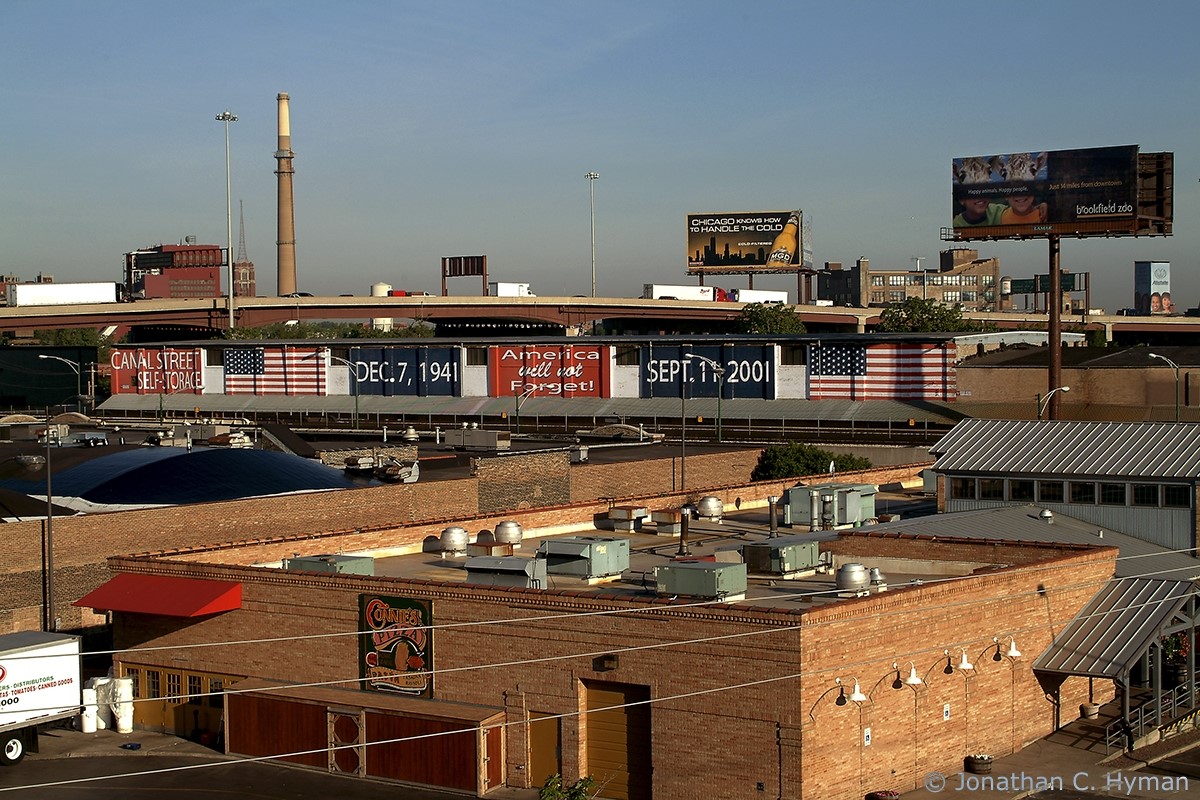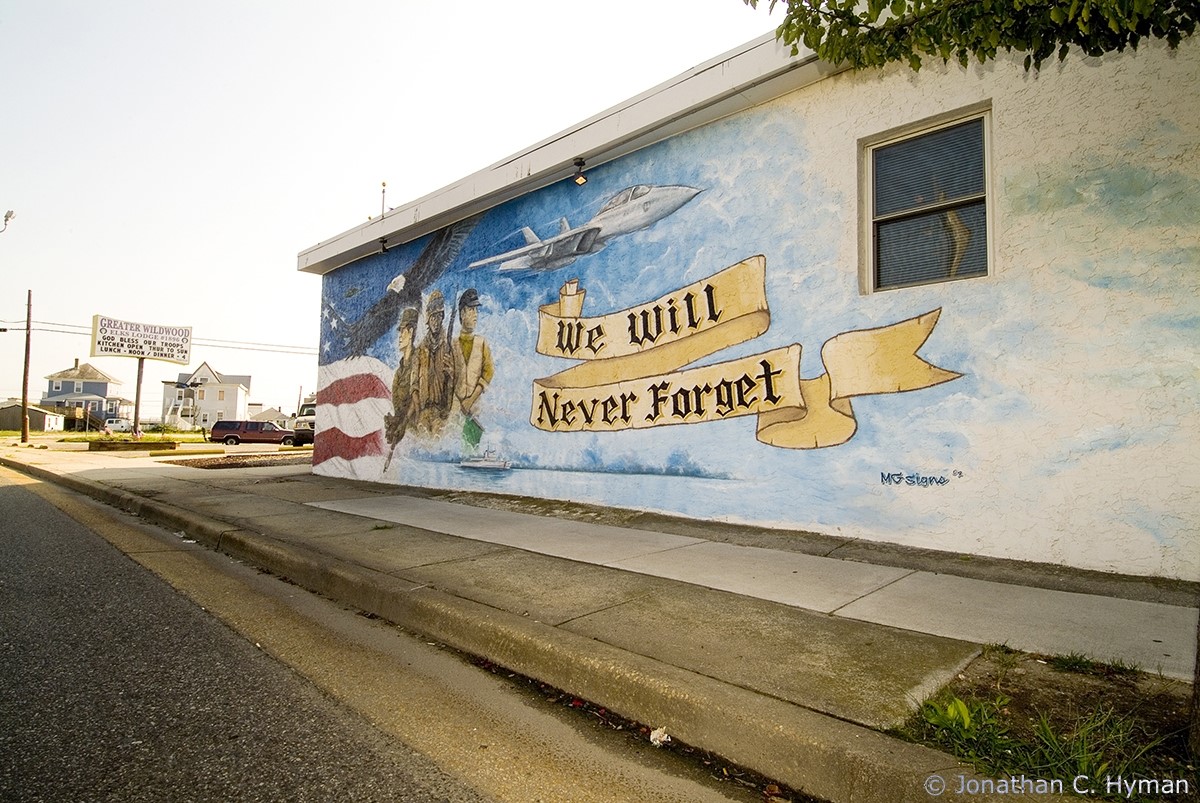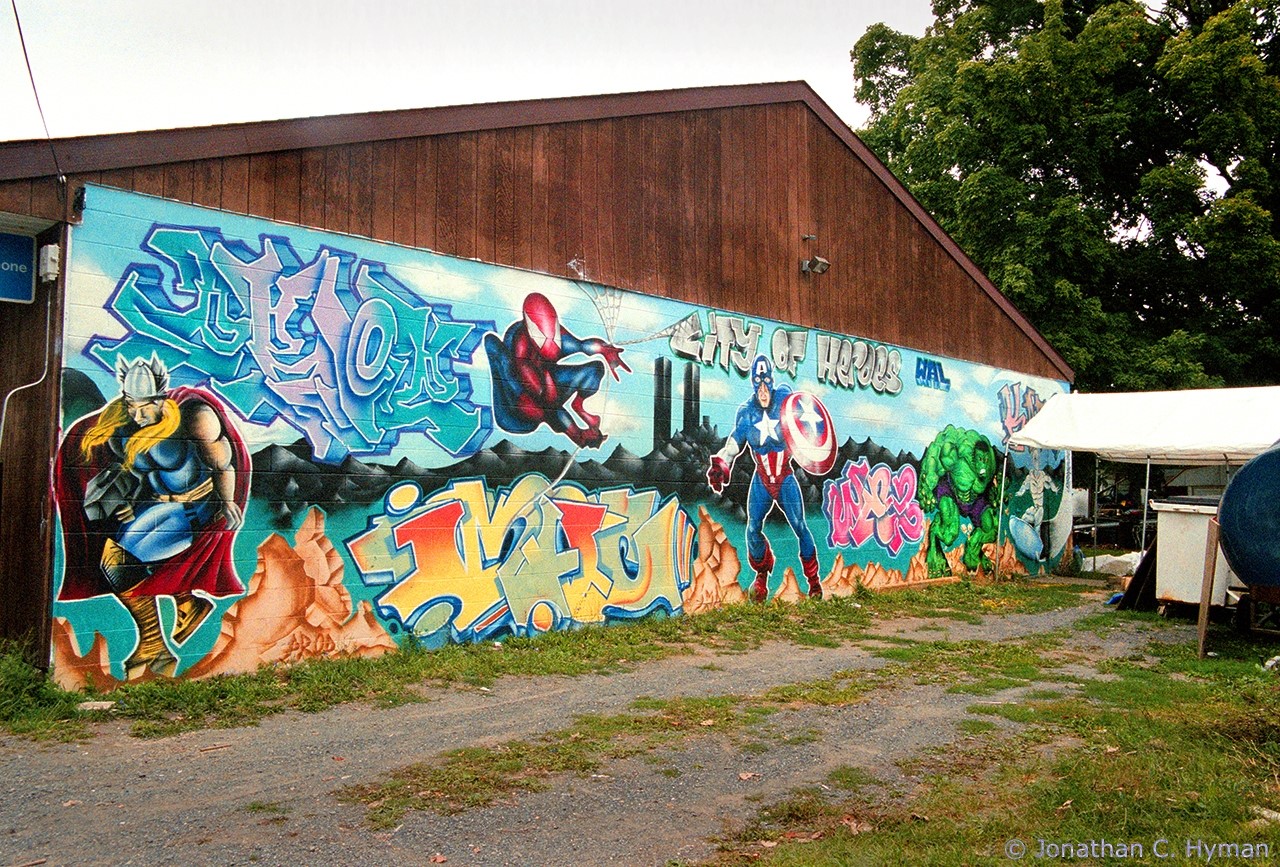Vernacular Art Connects 9/11 and Pearl Harbor
Vernacular Art Connects 9/11 and Pearl Harbor
- December 7, 2021
Immediately after the 9/11 attacks, artist and photographer Jonathan C. Hyman embarked on a journey with his car, his camera, and a ladder, on a mission to chronicle the "vernacular" art popping up across the country in response to the tragedy. This journey would last more than 10 years and take him from Maine to Florida to Illinois and beyond, where he photographed tributes on building walls, handball courts, vehicles, tree trunks, construction fencing, and even human skin. Our collection includes a broad cross-section of this series, including two photos that reference Pearl Harbor - attacked 80 years ago today - in their homages to September 11.
Eight decades after the “day that will live in infamy” and two since the one we will “never forget," Hyman spoke to us about his project of 10+ years and the pairing of the two historical events.
Define “vernacular” art, for those who may not know the term.
I would define vernacular art as a genre of artistic expression — often displayed and/or made in public — by people who are untrained and generally do not conceive of themselves as artists. The artwork and public expression in the aftermath of September 11 were the result of an incredible burst of creativity by many people making art for the first time. The common thread among almost all of what I photographed was the use by lay artists of objects, images, and iconography available in our popular culture.

What was the story behind the two photographs in our collection — where and how did you stumble upon them?
[Chicago mural, above] In 2005 I convinced my wife and daughter that it would be fun to drive from our home in Sullivan County, New York to a family event in Chicago. Neither of them wanted to fly and I, still engaged on a daily basis in photographing 9/11 related artwork, thought it would be a great opportunity to extend the geographic boundaries of my documentation. As we approached my cousin’s house on the freeway, I caught a huge blur of red, white, and blue out of the corner of my right eye. I immediately pushed my camera, always beside me in the car, into my wife’s hands. She was able to snap a few blurry photos as we sped by that were very helpful in tracking the mural down the following day. I returned to the mural several times before finding the right vantage point to photograph it in all of its very direct and concise grandeur.
Left: "Pine Bush I: Day of Infamy," Museum Purchase.
Right: "Pine Bush II: City of Heroes," Courtesy Jonathan C. Hyman
[Pine Bush, NY mural, above left] Less than a month after the attacks, I found myself in Pine Bush, NY. Lost on a side street, I encountered this mural. The phrase “A Day That will live in Infamy” at the bottom left of the mural is a direct reference to President Franklin Delano Roosevelt’s radio address to the nation in response to the Japanese attack on Pearl Harbor in 1941. Less obvious than the mural’s direct reference to American cultural history are two other elements that have appeared to varying degrees in other 9/11 murals. Above the "Day of Infamy" text, the World Trade Center towers are seen as rising to the heavens in an apotheosis. While the WTC towers ascend, in the bottom middle of the mural the New York City skyline appears in black, steadfast, metaphorically in mourning.
A year later I returned to this site and along with the red door and the outdoor public phone, the mural itself was gone from the landscape. Fortunately, the owner of the building commissioned another mural that he said was meant to be “more upbeat and forceful.” The second Pine Bush mural [above, right] features a handful of well-known comic book stars, including the World War II-era superhero Captain America.

"Wildwood: We Will Never Forget," Courtesy Jonathan C. Hyman.
Tell us a little about the Wildwood mural (at left).
Pearl Harbor is clearly referenced in the Wildwood mural as there is a warship in the water and deeper in the background one can see the plumes of smoke from the burning wreckage of war ships. This depiction of the Pearl Harbor attacks is now a common visual construction associated with the December 7, 1941 attack on Pearl Harbor. While there is no indication that this mural was made in direct response to the 9/11 attacks, it is a memorial mural made in 2004, within three years of the 9/11 attacks and at the beginning of the Iraq war. I do think this mural is relevant to the conversation surrounding the connection between the September 11th attacks and the one on Pearl Harbor as it employs the much used 9/11 phrase, "We Will Never Forget." This mural also includes imagery of the Bald Eagle, the American flag, and a scroll, all seen to varying degrees in 9/11 memorial murals, tattoos and other kinds of memorials and commemorations. The scroll was used as a devise by muralist Joe Indart in particular, to list the names of those civilians, firemen and other first responders who died in the attacks.
In your words, why did these artists link Pearl Harbor & 9/11? What underlying sentiment do they both tap into?
I spoke with the person who commissioned the mural in Chicago, the owner of the Pine Bush building who commissioned the murals, and one of the muralists who helped paint the first Pine Bush mural. All three made the Pearl Harbor connection. They felt that though 9/11 was, like Pearl Harbor, a horrendous attack on the nation, it would - particularly the destruction of the World Trade Center - come to stand for American resolve, perseverance, and military might.

Photograph by Hyman of Joe Indart's mural "Mt. Rushmore/9/11," in Brooklyn. Indart shows the famed faces of Mt. Rushmore in first responder protective gear, alongside symbols like the American flag, Statue of Liberty, and Manhattan skyline. The piece exemplifies the concept of iconography in the vernacular art inspired by 9/11. Courtesy Jonathan C. Hyman.
In your travels, have you seen recurring comparisons between 9/11 and any other historical events?
Vernacular art was made in the aftermath of the assassinations of Abraham Lincoln and John F. Kennedy and also the moon landing in 1969. I have photographed vernacular art that memorialized the in-air implosion of the Space Shuttle in 1986. I am currently working on an article that makes convincing visual and cultural connections between the September 11th attacks and the Vietnam War. Whether it be a one-day event or an ongoing war or crisis, these kinds of national catastrophes serve as cultural ruptures that change the way people think about themselves and indeed, how nations function. All serve to varying degrees, as signposts of our collective memory and national narrative. Because we have at our disposal now multiple social media platforms, I believe much of the public artwork that might have been made and displayed publicly during the pandemic has been disseminated electronically and is therefore not available for the kind of consumption that typically leads to photography.
Why is important that we preserve works of art like these?
The artworks and memorials I photographed are part of a dynamic process of remembrance surrounding a cataclysmic event and its aftermath. So powerfully and abundantly present in the landscape post-9/11, they tell the story of an unprecedented and spontaneous visceral outpouring of public expression. The artwork and memorials I photographed for well over a decade illustrate that the persistence of memory and the need to memorialize is now not only part of the history of the public memory of 9/11 but also inextricably connected to the changing history and interpretations of the attacks. Indeed, an argument can be made that this public history has and will help define our collective future. I believe and hope that a new generation of scholars and museum professionals, perhaps less burdened by personal and emotional connections to that fateful day and the wars that resulted from them, will study and exhibit my body of work with a vigor and evenhandedness that will enable our society to interpret 9/11 in ways that balance our need to commemorate with the more complex and demanding task of understanding who we are as a nation and what freedom and never forgetting mean in a world remade by the 9/11 attacks. Both the complexity of our memorial culture and the memory of those who perished on September 11 demand nothing less.
By 9/11 Memorial Staff
Previous Post
The Legacy Letters at 10: A Conversation With Suzann Cayne

In 2011, the organization Tuesday's Children compiled 100 letters written by family members to the loved ones they lost on 9/11, reflecting on a decade gone by. In this milestone 20th anniversary year, we've been speaking with some of the families who contributed "legacy letters" ten years ago. Today’s blog post features Suzann Cayne, who was seven when she lost her father Jake, a Cantor Fitzgerald employee.
Next Post
In Milestone Anniversary Year, Army-Navy Rivalry Game Takes On New Layer of Meaning
No matter what happens on the football field, the 131-year-old rivalry between the Army Black Knights and the Navy Midshipmen will always have sportsmanship, teamwork, and camaraderie at its core.

